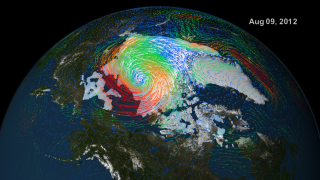Slicing And Dicing
An unusually strong storm formed off the coast of Alaska on August 5, 2012, and pushed into the center of the Arctic Ocean. The spiraling cyclone was intense by Arctic summer standards, but it caught NASA scientists' attention for a different reason. As the storm raked over the floating sea ice, it severed an enormous chunk from the primary mass of the ice cap. Once separated the freed ice melted faster. This accelerated rate of ice loss might have contributed to the new record low that Arctic sea ice reached on September 16, 2012. Scientists said that while the storm itself wasn't extraordinary, the long-term weakening of the sea ice makes a storm of this size far more impactful than it would have been several decades ago. The visualization, based on wind and sea ice satellite data, shows how the storm parted the ice in its path.

A summer cyclone at the top of the world tore through thinning Arctic sea ice.
Watch the cyclone create an ice island north of Alaska and eastern Russia. Dark red arrows represent winds traveling 31 miles per hour or faster.

The storm's spiral shape surfaced by Aug. 6 (left); appeared in tight formation by Aug. 9 (middle); and fell apart by Aug. 11 (right).

The Arctic ice cap was still one, large mass at the beginning of August, days before the storm formed.

Days after the storm died down, a large section of ice had separated from the ice cap.

This mosaic of the cyclone over the Arctic Ocean on Aug. 6 was created from multiple images captured by NASA's Aqua satellite.
Credits
Please give credit for this item to:
NASA's Goddard Space Flight Center
-
Animators
- Cindy Starr (Global Science and Technology, Inc.)
- Greg Shirah (NASA/GSFC)
- Horace Mitchell (NASA/GSFC)
-
Producer
- Jefferson Beck (USRA)
-
Scientists
- Josefino Comiso (NASA/GSFC)
- Robert Gersten (Wyle Information Systems)
-
Writers
- Maria-Jose Vinas Garcia (Telophase)
- Patrick Lynch (Wyle Information Systems)
Release date
This page was originally published on Thursday, September 27, 2012.
This page was last updated on Wednesday, May 3, 2023 at 1:52 PM EDT.
